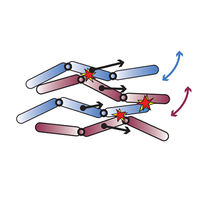Abstract
Many biological systems synchronize their movement through physical interactions. By far, the most well-studied examples concern physical interactions through a fluid: Beating cilia, swimming sperm and worms, and flapping wings all display synchronization behavior through fluid mechanical interactions. However, as the density of a collective increases, individuals may also interact with each other through physical contact. In the field of “active matter” systems, it is well known that inelastic contact between individuals can produce long-range correlations in position, orientation, and velocity. In this work, we demonstrate that contact interactions between undulating robots yield novel phase dynamics such as synchronized motions. We consider undulatory systems in which rhythmic motion emerges from time-independent oscillators that sense and respond to an undulatory bending angle and speed. In pair experiments, we demonstrate that robot joints will synchronize to in-phase and antiphase oscillations through collisions, and a phase-oscillator model describes the stability of these modes. To understand how contact interactions influence the phase dynamics of larger groups, we perform simulations and experiments of simple three-link undulatory robots that interact only through contact. Collectives synchronize their movements through contact as predicted by the theory, and when the robots can adjust their position in response to contact, we no longer observe antiphase synchronization. Lastly, we demonstrate that synchronization dramatically reduces the interaction forces within confined groups of undulatory robots, indicating significant energetic and safety benefits from group synchronization. The theory and experiments in this study illustrate how contact interactions in undulatory active matter can lead to novel collective motion and synchronization.
4 More- Received 12 December 2020
- Revised 10 May 2021
- Accepted 23 June 2021
DOI:https://doi.org/10.1103/PhysRevX.11.031051
Published by the American Physical Society under the terms of the Creative Commons Attribution 4.0 International license. Further distribution of this work must maintain attribution to the author(s) and the published article’s title, journal citation, and DOI.
Published by the American Physical Society
Physics Subject Headings (PhySH)
Popular Summary
Collective motion is a widely observed phenomenon across all scales of living systems, from bacteria to birds. When movement is oscillatory, for example in a beating flagellum or a swimming worm, forces between individuals can cause them to synchronize their movement. The physical interactions in these systems often occur through a fluid, which allows for long-range and continuous interactions. However, collective oscillatory systems are often tightly packed, so individuals can also collide with each other. The role of mechanical contact on the dynamics of synchronization is unknown and may yet present an important method by which active undulatory systems synchronize their movement. We present theory, simulation, and robotics experiments to study how such contact interactions generate novel phase dynamics such as synchronization.
We study this question at three levels of abstraction. First, we use simple models that represent the joints of robots to enumerate the phase dynamics. Second, we use numerical simulations to study larger groups of these simple oscillators. And third, we build three-link robots and study in experiment and simulation how undulatory gaits synchronize through contact. The undulatory motion in all cases is governed by a simple feedback equation, which enables the oscillator phase to change during contact. All these experiments are supported by a phase-oscillator theory of contact synchronization, which correctly predicts the onset and stability of the observed phenomenon.
Our work demonstrates that active, undulatory systems that interact through contact demonstrate a rich array of phase dynamics. This may help explain how undulatory biological systems, such as swimming worms, spermatozoa, and cilia, synchronize their movements when in close proximity.



